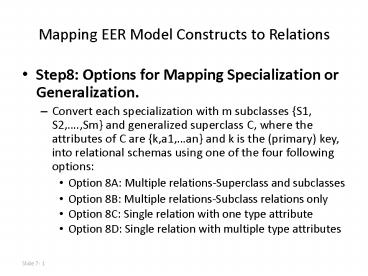Mapping EER Model Constructs to Relations - PowerPoint PPT Presentation
1 / 19
Title:
Mapping EER Model Constructs to Relations
Description:
Option 8D: Single relation with multiple type attributes ... must all have the same key attribute; otherwise, the shared subclass would ... – PowerPoint PPT presentation
Number of Views:129
Avg rating:3.0/5.0
Title: Mapping EER Model Constructs to Relations
1
Mapping EER Model Constructs to Relations
- Step8 Options for Mapping Specialization or
Generalization. - Convert each specialization with m subclasses
S1, S2,.,Sm and generalized superclass C,
where the attributes of C are k,a1,an and k is
the (primary) key, into relational schemas using
one of the four following options - Option 8A Multiple relations-Superclass and
subclasses - Option 8B Multiple relations-Subclass relations
only - Option 8C Single relation with one type
attribute - Option 8D Single relation with multiple type
attributes
2
Mapping EER Model Constructs to Relations
- Option 8A Multiple relations-Superclass and
subclasses - Create a relation L for C with attributes
Attrs(L) k,a1,an and PK(L) k. Create a
relation Li for each subclass Si, 1 lt i lt m, with
the attributesAttrs(Li) k U attributes of
Si and PK(Li)k. This option works for any
specialization (total or partial, disjoint of
over-lapping). - Option 8B Multiple relations-Subclass relations
only - Create a relation Li for each subclass Si, 1 lt i
lt m, with the attributes Attr(Li) attributes
of Si U k,a1,an and PK(Li) k. This option
only works for a specialization whose subclasses
are total (every entity in the superclass must
belong to (at least) one of the subclasses).
3
FIGURE 4.4EER diagram notation for an
attribute-defined specialization on JobType.
4
FIGURE 7.4Options for mapping specialization or
generalization. (a) Mapping the EER schema in
Figure 4.4 using option 8A.
5
FIGURE 4.3Generalization. (b) Generalizing CAR
and TRUCK into the superclass VEHICLE.
6
FIGURE 7.4Options for mapping specialization or
generalization. (b) Mapping the EER schema in
Figure 4.3b using option 8B.
7
Mapping EER Model Constructs to Relations (contd.)
- Option 8C Single relation with one type
attribute - Create a single relation L with attributes
Attrs(L) k,a1,an U attributes of S1 UU
attributes of Sm U t and PK(L) k. The
attribute t is called a type (or discriminating)
attribute that indicates the subclass to which
each tuple belongs - Option 8D Single relation with multiple type
attributes - Create a single relation schema L with attributes
Attrs(L) k,a1,an U attributes of S1 UU
attributes of Sm U t1, t2,,tm and PK(L) k.
Each ti, 1 lt I lt m, is a Boolean type attribute
indicating whether a tuple belongs to the
subclass Si.
8
FIGURE 4.4EER diagram notation for an
attribute-defined specialization on JobType.
9
FIGURE 7.4Options for mapping specialization or
generalization. (c) Mapping the EER schema in
Figure 4.4 using option 8C.
10
FIGURE 4.5EER diagram notation for an
overlapping (non-disjoint) specialization.
11
FIGURE 7.4Options for mapping specialization or
generalization. (d) Mapping Figure 4.5 using
option 8D with Boolean type fields Mflag and
Pflag.
12
Mapping EER Model Constructs to Relations (contd.)
- Mapping of Shared Subclasses (Multiple
Inheritance) - A shared subclass, such as STUDENT_ASSISTANT, is
a subclass of several classes, indicating
multiple inheritance. These classes must all have
the same key attribute otherwise, the shared
subclass would be modeled as a category. - We can apply any of the options discussed in Step
8 to a shared subclass, subject to the
restriction discussed in Step 8 of the mapping
algorithm. Below both 8C and 8D are used for the
shared class STUDENT_ASSISTANT.
13
FIGURE 4.7A specialization lattice with multiple
inheritance for a UNIVERSITY database.
14
FIGURE 7.5Mapping the EER specialization lattice
in Figure 4.6 using multiple options.
15
Mapping EER Model Constructs to Relations (contd.)
- Step 9 Mapping of Union Types (Categories).
- For mapping a category whose defining superclass
have different keys, it is customary to specify a
new key attribute, called a surrogate key, when
creating a relation to correspond to the
category. - In the example below we can create a relation
OWNER to correspond to the OWNER category and
include any attributes of the category in this
relation. The primary key of the OWNER relation
is the surrogate key, which we called OwnerId.
16
FIGURE 4.8Two categories (union types) OWNER
and REGISTERED_VEHICLE.
17
FIGURE 7.6Mapping the EER categories (union
types) in Figure 4.7 to relations.
18
Mapping Exercise
- Exercise 7.4.
FIGURE 7.7An ER schema for a SHIP_TRACKING
database.
19
Chapter Summary
- ER-to-Relational Mapping Algorithm
- Step 1 Mapping of Regular Entity Types
- Step 2 Mapping of Weak Entity Types
- Step 3 Mapping of Binary 11 Relation Types
- Step 4 Mapping of Binary 1N Relationship Types.
- Step 5 Mapping of Binary MN Relationship Types.
- Step 6 Mapping of Multivalued attributes.
- Step 7 Mapping of N-ary Relationship Types.
- Mapping EER Model Constructs to Relations
- Step 8 Options for Mapping Specialization or
Generalization. - Step 9 Mapping of Union Types (Categories).































